1994 BUICK REGAL heating
[x] Cancel search: heatingPage 11 of 308
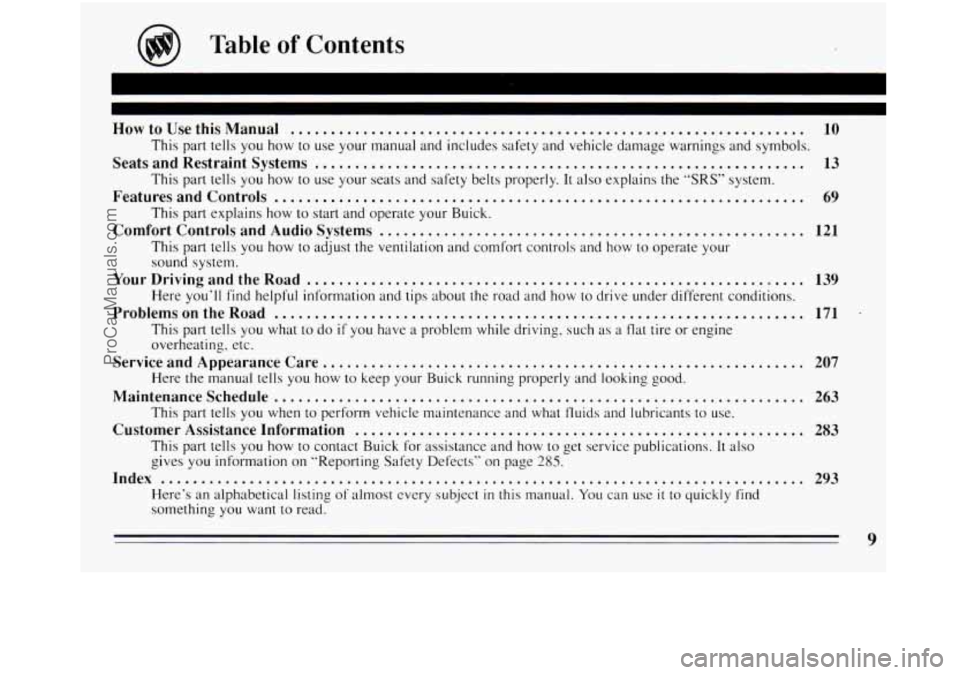
Table of Contents
HowtoUsethisManual ................................................................ 10
This part tells you how to use your manual and includes safety and vehicle damage warnings and symbols.
Seats and Restraint Systems .............................................................
This part tells you how to use your seats and safety belts properly. It also explains the ”SRS” system.
Featuresandcontrols ..................................................................
This part explains how to start and operate your Buick.
Comfort Controls and Audio Systems .....................................................
This part tells you how to adjust the ventilation and comfort controls and how to operate your
sound system.
Here you’ll
find helpful information and tips about the road and how to drive under different conditions.
This part tells you what to do
il‘ you have a problem while driving, such as a flat tire or engine
overheating. etc.
Service and Appearance Care.. ..........................................................
Here the manual tells you how to keep your Buick running properly and looking good.
Maintenanceschedule ..................................................................
This part tells you when to perform vehicle maintenance and what Iluids and lubricants to use.
Customer Assistance Information ........................................................
This part tells you how to contact Buick for assistance and how to get service publications. It also
gives you information on “Reporting Safety Defects” on page 285.
Index ........................................................................\
........
Here’s an alphabetical listing of almost every subject in this manual. You can use it to quickly find
something you want
to read.
YourDrivingandtheRoad ..............................................................
ProblemsontheRoad ..................................................................
13
69
121
139
171
207
263
283
293
9
ProCarManuals.com
Page 112 of 308
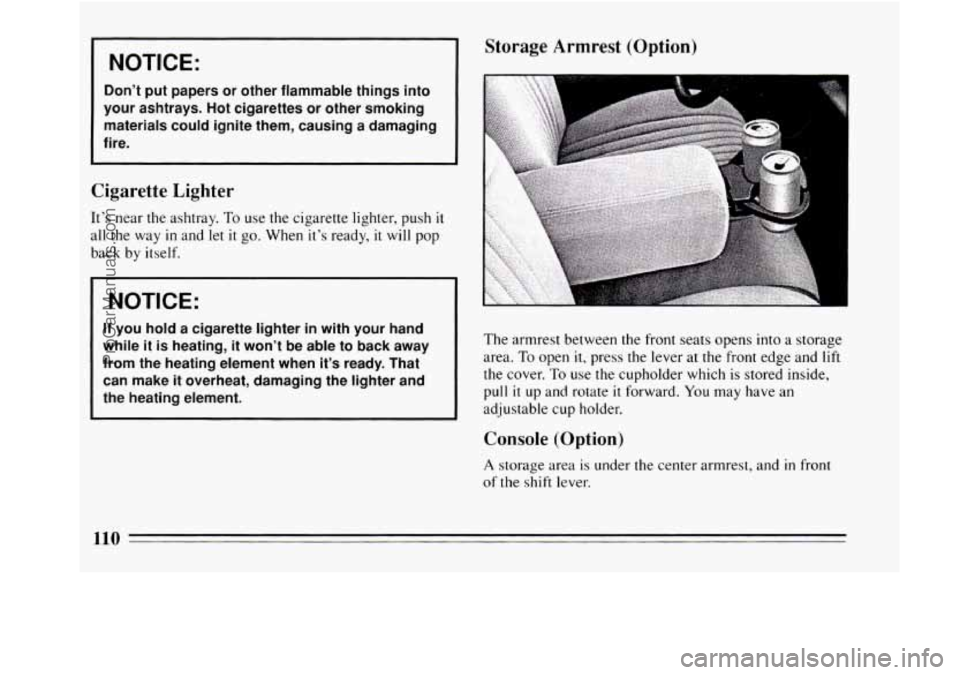
I NOTICE:
Don't put papers or other flammable things into
your ashtrays. Hot cigarettes or other smoking
materials could ignite them, causing a damaging
fire.
Cigarette Lighter
It's near the ashtray. To use the cigarette lighter, push it
all the way in and let it go. When it's ready, it will pop
back
by itself.
' NOTICE:
If you hold a cigarette lighter in with your hand
while
it is heating, it won't be able to back away
from the heating element when it's ready. That
can make
it overheat, damaging the lighter and
the heating element.
Storage Armrest (Option)
The armrest between the front seats opens into a storage
area.
To open it, press the lever at the front edge and lift
the cover.
To use the cupholder which is stored inside,
pull
it up and rotate it forward. You may have an
adjustable cup holder.
Console (Option)
A storage area is under the center armrest, and in front
of the shift lever.
110
ProCarManuals.com
Page 118 of 308
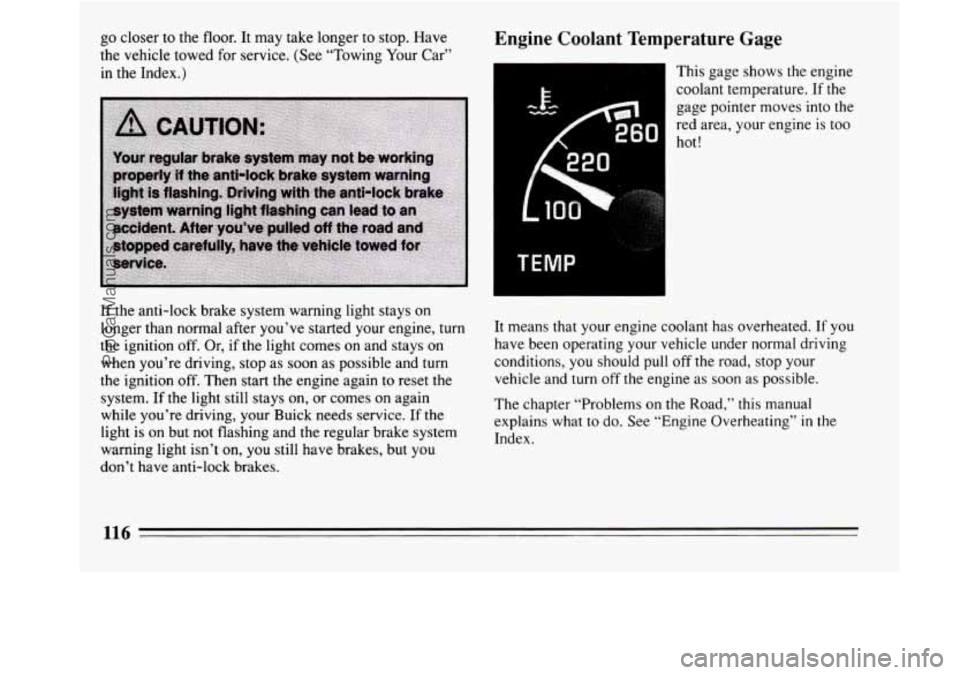
go closer to the floor. It may take longer to stop. Have
the vehicle towed for service. (See “Towing Your Car”
in the Index.) Engine Coolant Temperature Gage
This gage shows the engine
coolant temperature. If the
gage pointer moves into the
red area, your engine
is too
hot!
If the anti-lock brake system warning light stays on
longer than normal after you’ve started your engine, turn
the ignition off. Or,
if the light comes on and stays on
when you’re driving, stop as soon as possible and turn
the ignition off. Then start the engine again to reset the
system. If the light still stays on, or comes on again
while you’re driving, your Buick needs service. If the
light is on but not flashing and the regular brake system
warning light isn’t on,
you still have brakes, but you
don’t have anti-lock brakes. It means
that your engine coolant has overheated. If you
have been operating your vehicle under normal driving
conditions,
you should pull off the road, stop your
vehicle and turn off the engine as soon as possible.
The chapter “Problems on the Road,” this manual
explains what to do. See “Engine Overheating”
in the
Index.
116
ProCarManuals.com
Page 126 of 308
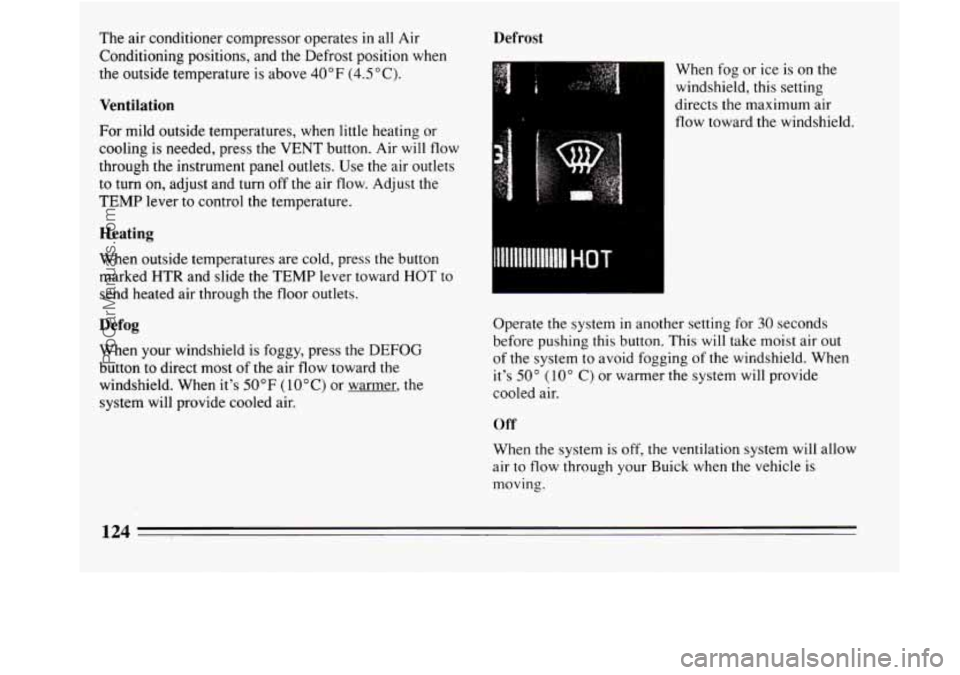
The air conditioner compressor operates in all Air
Conditioning positions, and the Defrost position when
the outside temperature is above
40°F (4.5"C).
Ventilation
For mild outside temperatures, when little heating or
cooling is needed, press the
VENT button. Air will flow
through the instrument panel outlets. Use the air outlets
to turn on, adjust and turn off the air flow. Adjust the
TEMP lever to control the temperature.
Heating
When outside temperatures are cold, press the button
marked HTR and slide the
TEMP lever toward HOT to
send heated air through the floor outlets.
Defog
When your windshield is foggy, press the DEFOG
button to direct most of the air flow toward the
windshield. When it's
50°F (IOOC) or warmer, the
system will provide cooled air.
Defrost
. When fog or ice is on the
windshield, this setting
directs the maximum air
flow toward the windshield.
Operate the system
in another setting for 30 seconds
before pushing this button. This
will take moist air out
of the system to avoid fogging
of the windshield. When
it's 50" (10" C) or warmer the system will provide
cooled air.
Off
When the system is off, the ventilation system will allow
air to flow through your Buick when the vehicle is
moving.
124
ProCarManuals.com
Page 127 of 308

Rear Window Defogger (Option) Audio Systems
The lines you see on the
rear window warm the
glass. Press the button to
start warming your
window. After
10 minutes,
it
will go off by itself or
pressing the button again
during the heating cycle
will shut it off. If you need
additional warming time,
push the button again, the
defogger will go off after
5 minutes. Your
DelcoB audio system has been designed to operate
easily and give years of listening pleasure. But you will
get the most enjoyment out of it if you acquaint yourself
with
it first. Find out what your Delco@ system can do
and how to operate all its controls, to be sure you’re
getting the most out
of the advanced engineering that
went into it.
FM Stereo
FM stereo will give you the best sound. But FM signals
will reach only about
10 to 40 miles (16 to 65 km). And,
tall buildings or hills can interfere with FM signals,
causing
the sound to come and go.
AM
NOTICE:
Scraping the inside of your rear window could
cut and damage the heater. Your warranty would
not cover this damage. And don’t put decals
there;
you might have to scrape them off.
The range for most AM stations is greater than for FM,
especially at night. The longer range, however, can
cause stations to interfere with each other. AM can pick
up noise from things like storms and power lines. Try
reducing
the treble to reduce this noise.
-
125
ProCarManuals.com
Page 170 of 308

Following Distance
Stay at least twice as far behind the vehicle ahead as you
would when driving your vehicle without a trailer. This
can help you avoid situations that require heavy braking
and sudden turns.
Passing
You’ll need more passing distance up ahead when
you’re towing a trailer. And, because you’re a good deal
longer, you’ll need
to go much farther beyond the
passed vehicle before
you can return to your lane.
Backing Up
Hold the bottom of the steering wheel with one hand.
Then,
to move the trailer to the left, just move that hand
to the left.
To move the trailer to the right, move your
hand
to the right. Always back up slowly and, if
possible, have someone guide you.
Making Turns
When you’re turning with a trailer, make wider turns
than normal.
Do this so your trailer won’t strike soft
shoulders, curbs, road signs, trees, or other objects.
Avoid jerky or sudden maneuvers. Signal well
in
advance.
Turn Signals When Towing a Trailer
When you tow a trailer, your vehicle has to have a
different turn signal flasher and extra wiring. The green
arrows
on your instrument panel will flash whenever
you signal a turn or lane change. Properly hooked up,
the trailer lights will also flash, telling other drivers
you’re about to turn, change lanes or stop.
When towing a trailer,
the green arrows on your
instrument panel will flash for turns even
if the bulbs on
the trailer are burned out. Thus, you may think drivers
behind you are seeing your signal when they are
not. It’s
important to check occasionally to be sure the trailer
bulbs are still working.
Driving On Grades
Reduce speed and shift to a lower gear before you start
down a long or steep downgrade. If you don’t shift
down,
you might have to use your brakes so much that
they would get hot and no longer work
well.
On a long uphill grade, shift down and reduce your
speed to around
45 mph (70 km/h) to reduce the
possibility
of engine and transaxle overheating.
If you are towing a trailer that weighs more than
1,000
pounds (450 kg), you may prefer to drive in “D” instead
of Overdrive (or, as you need to, a lower gear).
168
ProCarManuals.com
Page 173 of 308
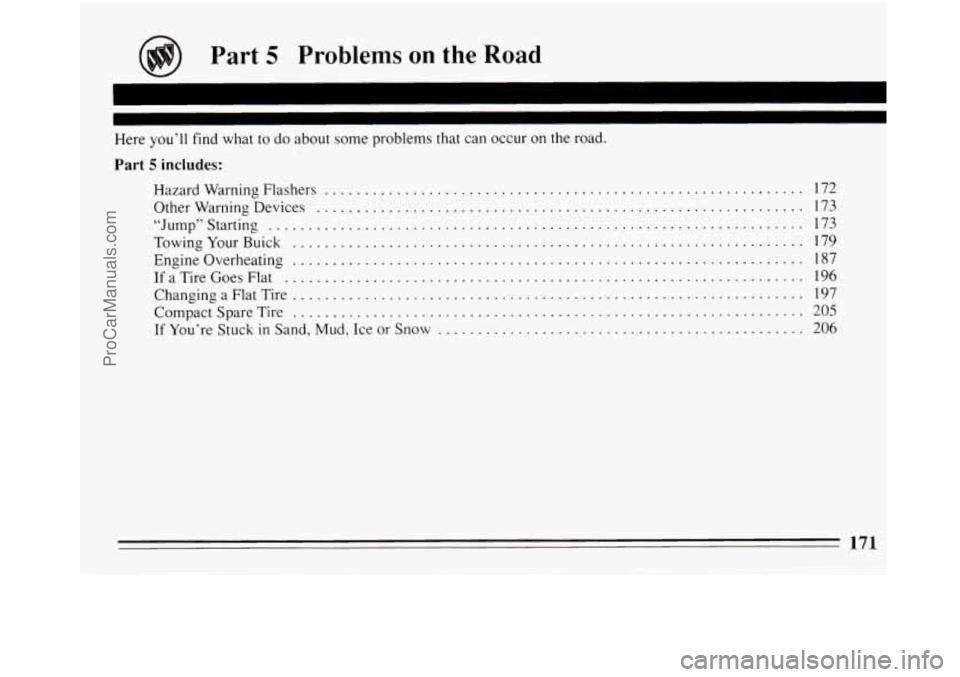
Part 5 Problems on the Road
Here you’ll find what to do about some problems that can occur on the road .
Part 5 includes:
Hazard Warning Flashers ............................................................
OtherWarningDevices .............................................................
“Jump”Starting ...................................................................
TowingYourBuick ................................................................
Engineoverheating ................................................................
IfaTireGoesFlat .................................................................
ChangingaFlatTire ................................................................
CompactSpareTire ................................................................
If You’re Stuck in Sand, Mud, Ice or Snow ..............................................
172
173
173
179
187
196 197
205
206
171
ProCarManuals.com
Page 189 of 308

Engine Overheating
You will find the coolant temperature gage on your
instrument panel.
You may also find a low coolant
warning light.
If Steam Is Coming From Your Engine
I NOTICE:
If your engine catches fire because you keep
driving with no coolant, your vehicle can be
badly damaged. The costly repairs would not be
covered by your warranty.
If No Steam Is Coming From Your Engine
If you get the overheat warning but see or hear no
steam, the problem may not be too serious. Sometimes
the engine can get a little too hot when you:
Climb a long hill on a hot day.
Stop after high speed driving.
Idle for long periods in traffic.
0 Tow a trailer.
187
ProCarManuals.com